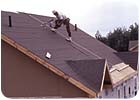SafetyAdvice: Anchorage Force Testing
A typical problem with the majority of construction jobsites is a lack of qualified persons (QP) to determine if any point of anchorage is capable of resisting the kinetic terminal impact force (TIF) of all of the potential anchorage points. By "capable," I mean the ability to resist TIFs without failure. The term "failure" in the OSHA standard is defined as "load refusal, breakage, or separation of component parts."

[Editor's note: This article is the second installment of a three-part series on anchorage points and personal fall arrest systems. In this article, the anchorage force test is explained.]
A typical problem with the majority of construction jobsites is a lack of qualified persons (QP) to determine if any point of anchorage is capable of resisting the kinetic terminal impact force (TIF) of all of the potential anchorage points. By "capable," I mean the ability to resist TIFs without failure. The term "failure" in the OSHA standard is defined as "load refusal, breakage, or separation of component parts."
The only qualitative method of on-site anchor point failure analysis is known as the anchorage force test (AFT). While it may not produce the quantitative analytical results achieved by the QP engineering the PFAS system, it is a site-specific, demonstrative procedure typically used by the competent person (CP) to ensure the safety of components and subsystems within the personal fall arrest system.
As any construction project continues, the personal fall arrest systems must be continually disassembled behind and reassembled ahead of the workforce in order to maintain both safety and productivity on a dependable schedule. It is only reasonable that the pre-bid walk-through and bid estimate documents contain a thorough, technical plan (developed from a job safety analysis) for installing progressive, on-site anchorage points for PFAS. Each one of these loci would be accompanied by it's specific TIF analysis with a two-times safety factor, depending on how many workers would be expected to work at that station for any length of time.
You may notice a variety of anchorage fastening options designed as adequate by the QP and made available to the CP to select from, depending on site conditions. There are many temporary and permanent roof anchors available on the market that fasten by screwing lag-bolts with washers into a plate or strap through the roof deck terminating in the rafters or trusses below. These require precise placement and careful installation by an experienced and trained tradesman in accordance to the manufacturer's instructions. Any deviation from procedures or carelessness in application can damage either the timber or the anchor device, reducing the ultimate resistant strength of the anchor. There are others systems that apply around the roof truss or rafter by means of a U-bolt device through a top plate, which is installed with locknuts and washers. More effort on the part of the erectors will be required with this system, but the TIF will be resisted by means of a compressive member rather than one in pull or shear tension. Once finally installed in a finished roof, the exposed D-ring anchors may appear identical while their ability to remove the fall hazard may vary greatly.


Post-test procedures should always require that the test anchor be removed and an identical replacement attached in its place. A failed test would require anchor re-evaluation and design before a second, improved anchor design is tested. The CP should also perform a thorough visual inspection of the structure in the immediate area of the deceleration forces applied by the anchor device. Note any physical damage, deterioration or deflection visually indicated. Competent repairs or replacement on sub-structure materials damaged in the testing should be conducted and documented immediately upon discovery.
The principles behind terminal impact force (TIF) analysis and anchorage force testing (AFT) are logical. These procedures are intended to establish the safe design criteria and ensure the adequate installation of any and all primary and secondary anchorage points in a personal fall arrest system. Where PFAS training and equipment are adequate and safe work practices verified according to the employer's fall prevention and protection program, then the last matter of concern would be the system's primary and secondary anchorage points. If all of the components and subsystems of the PFAS resist failure in an arrested fall, but the anchor points fail, the result is the same as if the victim wore no harness at all.
There is a colloquial term used in traditional rock climbing and high-angle rope rescue known as "bombproof." It is an adjective used to describe specific methods, materials and equipment that are designed with such a safety factor as to be physically indestructible and literally dependable under all conditions all the time.
In my opinion, it is certainly reasonable to expect the primary and secondary (backup) anchors in my own PFAS to successfully resist the terminal impact forces of an arrested fall I may experience - any fall, anywhere, at any time. If I'm stationary prior to my fall, these forces will be applied in six-tenths of a second upon my leaving the unprotected edge. If I happened to have gathered any momentum prior to my leaving the elevated surface, then I will reach a higher terminal velocity in a 6-foot freefall in much less time, with considerably more terminal impact force. This is precisely why OSHA mandates a minimum safety factor of two times. Go ahead. Be bold. Make it four times if you want to. While the design and installation of your anchor points may not be entirely your responsibility on the job, whether or not you eventually tie into a PFAS that depends on them is entirely up to you.
Unsafe work practices and workplaces are prohibited for every worker everywhere under Section 5(a)(1) of the OSH Act. So inspect each one thoroughly before, during and after each use of the system. Don't hesitate, don't hurry and, by all means necessary, when in doubt, tag them out. Let's totally eliminate those fatal falls caused every year by anchor point failure.
Next month's article is the conclusion of the three- part anchorage safety series. It will concentrate on the safe work practices involved with directly connecting your PFAS system to your primary and secondary anchor points, as well as some of the most innovative and adaptable personal anchorage devices on the market today. For additional information on calculating terminal impact force (TIF), click the link below.

Photo courtesy of DBI/SALA.
[Editor's note: This article is the second installment of a three-part series on anchorage points and personal fall arrest systems. In this article, the anchorage force test is explained.]
A typical problem with the majority of construction jobsites is a lack of qualified persons (QP) to determine if any point of anchorage is capable of resisting the kinetic terminal impact force (TIF) of all of the potential anchorage points. By "capable," I mean the ability to resist TIFs without failure. The term "failure" in the OSHA standard is defined as "load refusal, breakage, or separation of component parts."
The only qualitative method of on-site anchor point failure analysis is known as the anchorage force test (AFT). While it may not produce the quantitative analytical results achieved by the QP engineering the PFAS system, it is a site-specific, demonstrative procedure typically used by the competent person (CP) to ensure the safety of components and subsystems within the personal fall arrest system.
As any construction project continues, the personal fall arrest systems must be continually disassembled behind and reassembled ahead of the workforce in order to maintain both safety and productivity on a dependable schedule. It is only reasonable that the pre-bid walk-through and bid estimate documents contain a thorough, technical plan (developed from a job safety analysis) for installing progressive, on-site anchorage points for PFAS. Each one of these loci would be accompanied by it's specific TIF analysis with a two-times safety factor, depending on how many workers would be expected to work at that station for any length of time.
You may notice a variety of anchorage fastening options designed as adequate by the QP and made available to the CP to select from, depending on site conditions. There are many temporary and permanent roof anchors available on the market that fasten by screwing lag-bolts with washers into a plate or strap through the roof deck terminating in the rafters or trusses below. These require precise placement and careful installation by an experienced and trained tradesman in accordance to the manufacturer's instructions. Any deviation from procedures or carelessness in application can damage either the timber or the anchor device, reducing the ultimate resistant strength of the anchor. There are others systems that apply around the roof truss or rafter by means of a U-bolt device through a top plate, which is installed with locknuts and washers. More effort on the part of the erectors will be required with this system, but the TIF will be resisted by means of a compressive member rather than one in pull or shear tension. Once finally installed in a finished roof, the exposed D-ring anchors may appear identical while their ability to remove the fall hazard may vary greatly.

Here a static pull-out test is conducted on Super Anchor's RS-20 roof anchor (www.superanchor.com) by Rod-Lang Peach of American Shingles Ltd. in Australia (www.americanshingles.com.au) in conjunction with PRYDA and Hudson Truss & Bunning Co. About 90 percent of roof structures in Australia and New Zealand involve manufactured lumber trusses (Radiata pine) with tiles and metal the prevailing finish roof. As American Shingles Ltd. is currently introducing American manufactured asphalt shingles (from CertainTeed) to the market, it has simultaneously brought a world-wide selection of personal fall arrest equipment to the attention of the design-build workforce. (Photo courtesy of American Shingles Ltd. and Super Anchor Safety.)
The Test
A recommended anchorage force test (AFT) has been developed by the American National Standards Institute for determining compliance with their approved standard for personal fall arrest systems. The general control conditions for this test should closely simulate those of trained personnel competently utilizing a properly installed, personal fall arrest system in locations similar to the actual fall protection site. The specific structural test criteria include:- Lifelines, lanyards (with deceleration devices) should be attached to the proposed anchorage point and installed on an approved full body harness.
- All PFAS equipment should be evaluated and tested under the environmental conditions (rain, ice, wind, dirt, grease, etc.) for which the device is intended and the use is expected.
- A test weight should be a rigid, metal, cylindrical or torso-shaped object with a girth of 38 inches (±4 inches) weighting 220 pounds (±3 pounds) and shall be attached to the lifeline using an approved full body harness.
- The lanyard's total free-fall length shall allow the test weight to fall a maximum of 6 feet (±2 inches) when measured vertically from the anchor point to the terminally suspended harness' dorsal D-ring.
- The test weight should fall free from the anchorage level to its hanging location for a total (free-fall) distance of 6 feet without interference, obstruction or hitting the floor or ground during the test.
- The entire system fails the force test if the recorded maximum arresting force exceeds 2,520 pounds (11.2 kN) when using a body harness attached to a deceleration device lanyard.
- The anchorage point fails the force test if (1) it should no longer prove to be "rigidly attached," or (2) it should defect greater that 1mm (0.04 inches) when a force of 2,250 pounds (10kN) is applied in the drop test.

Photo courtesy of DBI/SALA.
Verifying the Results
A state-certified materials testing laboratory may be obviously recommended in order to accurately verify and legally document the final force test results in a fashion that could withstand cross-examination in court. It is certainly reasonable, however, that an on-site drop test could be effectively implemented and evaluated by the CP with photo-documentation whenever the physical strength of an anchorage point should be in doubt.Post-test procedures should always require that the test anchor be removed and an identical replacement attached in its place. A failed test would require anchor re-evaluation and design before a second, improved anchor design is tested. The CP should also perform a thorough visual inspection of the structure in the immediate area of the deceleration forces applied by the anchor device. Note any physical damage, deterioration or deflection visually indicated. Competent repairs or replacement on sub-structure materials damaged in the testing should be conducted and documented immediately upon discovery.
The principles behind terminal impact force (TIF) analysis and anchorage force testing (AFT) are logical. These procedures are intended to establish the safe design criteria and ensure the adequate installation of any and all primary and secondary anchorage points in a personal fall arrest system. Where PFAS training and equipment are adequate and safe work practices verified according to the employer's fall prevention and protection program, then the last matter of concern would be the system's primary and secondary anchorage points. If all of the components and subsystems of the PFAS resist failure in an arrested fall, but the anchor points fail, the result is the same as if the victim wore no harness at all.
There is a colloquial term used in traditional rock climbing and high-angle rope rescue known as "bombproof." It is an adjective used to describe specific methods, materials and equipment that are designed with such a safety factor as to be physically indestructible and literally dependable under all conditions all the time.
In my opinion, it is certainly reasonable to expect the primary and secondary (backup) anchors in my own PFAS to successfully resist the terminal impact forces of an arrested fall I may experience - any fall, anywhere, at any time. If I'm stationary prior to my fall, these forces will be applied in six-tenths of a second upon my leaving the unprotected edge. If I happened to have gathered any momentum prior to my leaving the elevated surface, then I will reach a higher terminal velocity in a 6-foot freefall in much less time, with considerably more terminal impact force. This is precisely why OSHA mandates a minimum safety factor of two times. Go ahead. Be bold. Make it four times if you want to. While the design and installation of your anchor points may not be entirely your responsibility on the job, whether or not you eventually tie into a PFAS that depends on them is entirely up to you.
Unsafe work practices and workplaces are prohibited for every worker everywhere under Section 5(a)(1) of the OSH Act. So inspect each one thoroughly before, during and after each use of the system. Don't hesitate, don't hurry and, by all means necessary, when in doubt, tag them out. Let's totally eliminate those fatal falls caused every year by anchor point failure.
Next month's article is the conclusion of the three- part anchorage safety series. It will concentrate on the safe work practices involved with directly connecting your PFAS system to your primary and secondary anchor points, as well as some of the most innovative and adaptable personal anchorage devices on the market today. For additional information on calculating terminal impact force (TIF), click the link below.
Links
Looking for a reprint of this article?
From high-res PDFs to custom plaques, order your copy today!



